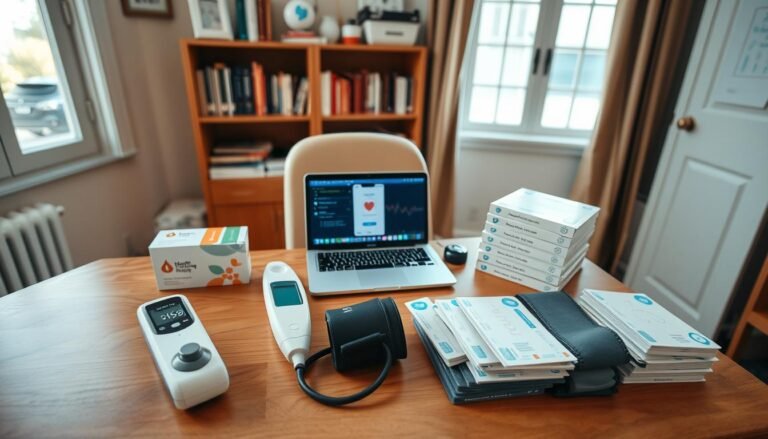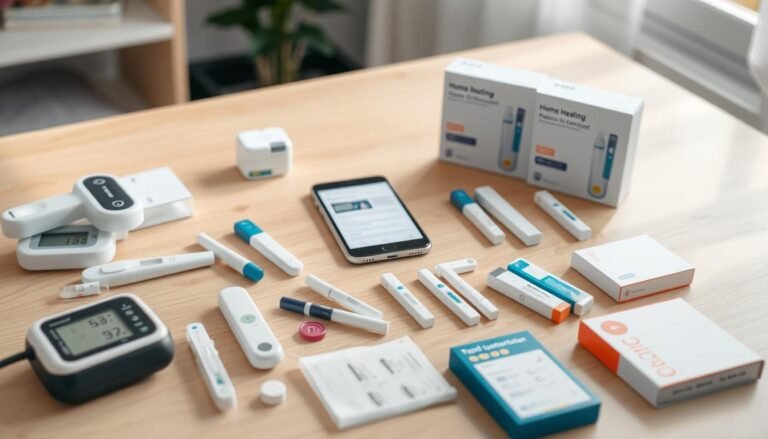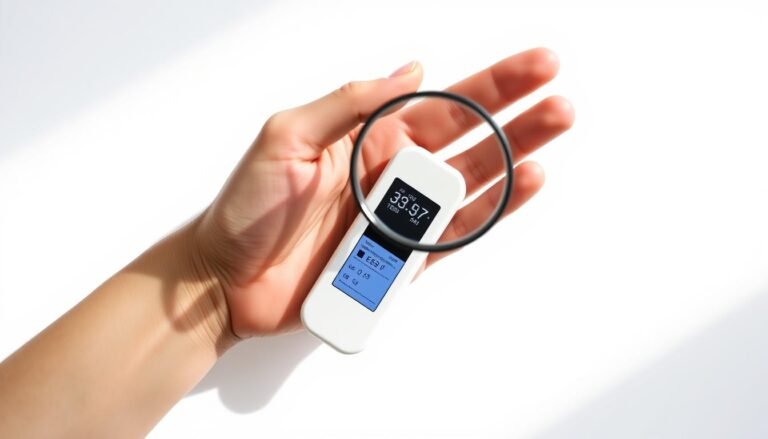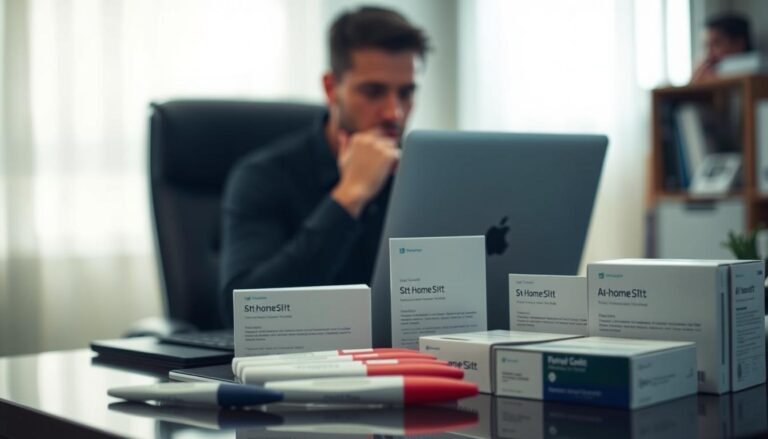At-Home Cholesterol Testing: How It Works and What Results Mean
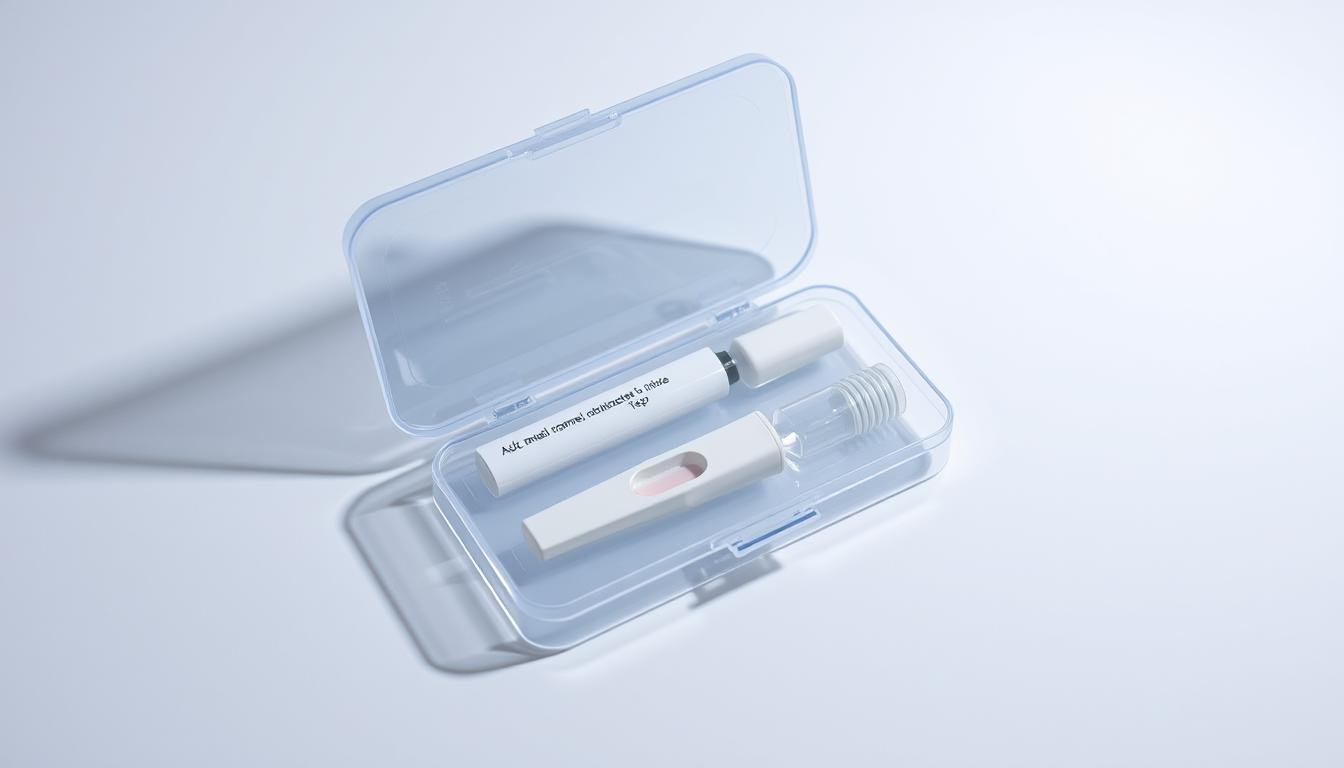
Can a simple finger-prick change how we protect our hearts and spot risk early?
We introduce a straightforward at home cholesterol test that uses a small blood sample to measure total, LDL, HDL and triglycerides. This quick check helps us see key numbers that guide daily choices for cardiovascular health.
We explain what each result means: high LDL raises artery plaque risk, higher HDL is protective, and triglycerides reflect recent meals and metabolism. Fasting nine to twelve hours often improves accuracy for triglyceride readings.
We set clear expectations on how the kit works, how fast results appear, and why tracking values over time matters more than a single reading. If values rise—especially total above 200 mg/dL—we should share findings with our clinician.
Why checking cholesterol at home matters for heart health
Regular checks of key blood markers help us spot trends that affect heart health. Knowing these numbers gives a fuller picture than a single visit to a clinic.
What each number tells us
Total cholesterol is an umbrella measure. It combines HDL and LDL and gives a quick snapshot.
LDL is the “bad” lipoprotein. It drives plaque buildup in artery walls and can narrow vessels over time.
HDL is the “good” carrier. It helps remove LDL and lower disease risk.
Triglycerides are blood fats that rise after meals. High values increase cardiovascular risk and may need fasting for accurate readings.
How high values raise risk
- High LDL and triglycerides speed atherosclerosis, which narrows arteries.
- Blockages reduce blood flow, which can cause a heart attack or stroke.
- Routine checks help estimate our risk and guide prevention with lifestyle and medical plans.
| Marker | Role | Why it matters | Action |
|---|---|---|---|
| Total cholesterol | Combined measure | Quick snapshot of overall levels | Track trend over time |
| LDL | Bad cholesterol | Drives plaque and narrows arteries | Lower with diet, meds if needed |
| HDL | Good transporter | Helps remove LDL | Increase with exercise |
| Triglycerides | Blood fats | Higher after meals; raise risk | Improve with diet and fasting 9–12 hrs |
Types of at-home cholesterol tests and when to use them
Several convenient tools now give us clear lipid data from a fingertip or a mailed sample.
Meter-based systems
Portable meters such as CardioChek and Curo L5 use a cartridge or strip and a small device. A fingertip drop yields a full lipid profile—total cholesterol, ldl, hdl, and triglycerides—often within minutes.
Mail-in collection kits
Brands like LetsGetChecked and Everlywell send a kit for home collection and ship the sample to a certified laboratory. Labs return secure digital results and reports suitable for clinicians.
Color-change test strips
Strip kits estimate only total cholesterol. They are cheap and quick for basic screening but do not provide ldl, hdl, or triglycerides for a full picture.
Accuracy and FDA-cleared options
- FDA-cleared devices can match lab accuracy when used correctly.
- Follow instructions, use unexpired materials, and fast if required for triglycerides.
- Consider lab follow-up if our results are unexpected or inconsistent.
| Type | What it measures | Speed | Best for |
|---|---|---|---|
| Meter-based system | Total cholesterol, ldl, hdl, triglycerides | Minutes | Frequent tracking and immediate results |
| Mail-in kit | Full profile via certified lab | Days (turnaround varies) | Lab-quality confirmation and clinician reports |
| Color-change strip | Total cholesterol only | Minutes | Quick screening, low cost |
How to use an at home cholesterol test: a step-by-step guide
Simple steps before and during collection help ensure an accurate lipid reading. Follow this routine so our numbers are useful for decisions with our provider.
Preparation and fasting guidance
We fast 9–12 hours if the kit instructions say so. Drink only water during this time to avoid skewed triglyceride values.
Collecting the finger-prick sample
We wash and warm our hands first. Choose a side of the fingertip and use the supplied lancet for a single, gentle prick.
Collect the drop without heavy squeezing and apply it to the test strip or cartridge exactly as directed.
Timing, reading, and recording
Start the device and wait the indicated minutes for the meter to process the blood. For color strips, read within the specified time window to avoid errors.
Record total numbers: total, LDL, HDL, and triglycerides if provided. Note the date, time, fasting status, and any recent diet or activity changes.
When to repeat or confirm with a lab
Repeat a test if the sample looked diluted, the strip was expired, or results seem inconsistent. Arrange a lab lipid panel when repeated readings are high.
Contact our provider if total cholesterol exceeds 200 mg/dL or if LDL and triglycerides are unusually elevated.
| Step | Action | Why it matters |
|---|---|---|
| Preparation | Fast 9–12 hours; hydrate with water | Improves triglyceride accuracy |
| Collection | Warm hands, use lancet, avoid squeezing | Prevents dilution of the blood sample |
| Processing | Apply to test strip/cartridge; wait minutes | Ensures the meter or strip gives reliable results |
| Follow-up | Repeat if uncertain; confirm with lab | Validates abnormal readings for clinical decisions |
Understanding your test results and what the numbers mean
Clear ranges let us quickly see whether our lipid indicators fall into safe or concerning zones.
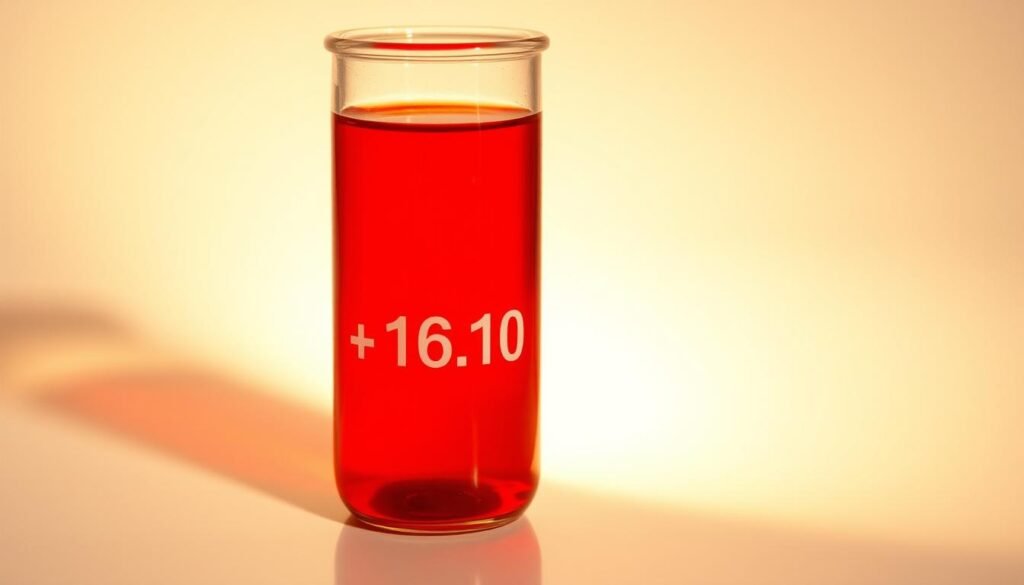
Healthy ranges to compare
Common reference points help us judge where our numbers stand.
Typical targets: total cholesterol under 200 mg/dL, ldl under 100 mg/dL, hdl 60 mg/dL or higher, and triglycerides under 150 mg/dL.
How to interpret borderline or high values
A total cholesterol level that reads high matters more when ldl and hdl are considered. A favorable hdl can offset some risk, while high ldl raises the chance of artery disease.
LDL on our report may be calculated from total, hdl, and triglycerides or measured directly. Either way, lower ldl generally reduces heart risk.
- Elevated triglycerides often track with diet, weight, and blood sugar control.
- Repeat test results on another day if values seem odd, and arrange a lab lipid panel for confirmation.
- Document results over time and work with our provider to set personalized targets based on age and health history.
| Marker | Healthy range | What it signals | Next step |
|---|---|---|---|
| Total cholesterol | <200 mg/dL | Overall summary of blood fats | Track trends; tell provider if >200 mg/dL |
| LDL | <100 mg/dL | Main driver of plaque buildup | Lower with diet, activity, or meds |
| HDL | ≥60 mg/dL | Protects against artery buildup | Increase with exercise and quitting smoking |
| Triglycerides | <150 mg/dL | Related to recent meals and metabolism | Improve with fasting, diet, and weight loss |
From results to action: lowering risk with lifestyle and medical care
A clear result gives us an opportunity to act—by changing habits or working with our clinician.
Diet, activity, weight, and stress
We focus on diet exercise changes that lower cholesterol. That means cutting saturated fat, choosing whole grains, and adding fiber-rich foods.
Regular physical activity helps lower LDL and raise HDL. Aim for consistent weekly movement that fits our routine, such as brisk walks, cycling, or structured workouts.
Managing weight, quitting smoking, moderating alcohol, improving sleep, and steps to reduce stress all support better health and lower heart disease risk.
When we may need medications
Even with lifestyle change, we may need prescriptions if risk stays high or levels remain above goal. Providers personalize plans based on overall risk profiles.
Statins are common; other agents may be added depending on tolerance and need. Medication is paired with nutrition and activity, with monitoring for benefits and side effects.
Tracking progress with testing and lab follow-ups
We use at‑home testing to see how new routines or drugs affect numbers, checking at intervals our provider recommends.
Keep testing conditions consistent—fast when advised—and schedule lab follow-ups to validate changes and refine the plan. Steady habits and measured care lower long-term risk.
| Action | Why it helps | When to follow up |
|---|---|---|
| Reduce saturated fat, increase fiber | Lowers LDL and improves lipid profile | Check levels after 6–12 weeks of change |
| Regular physical activity | Raises HDL and aids weight control | Review progress every 3 months |
| Medication when needed | Targets high LDL and overall risk | Monitor labs and symptoms per provider plan |
Practical tips for India: timing, lab confirmation, and accessing reports
Planning when we collect a sample and where we send it makes a big difference. Good timing helps us meet the 9–12 hour fasting window and gives clearer triglyceride levels.
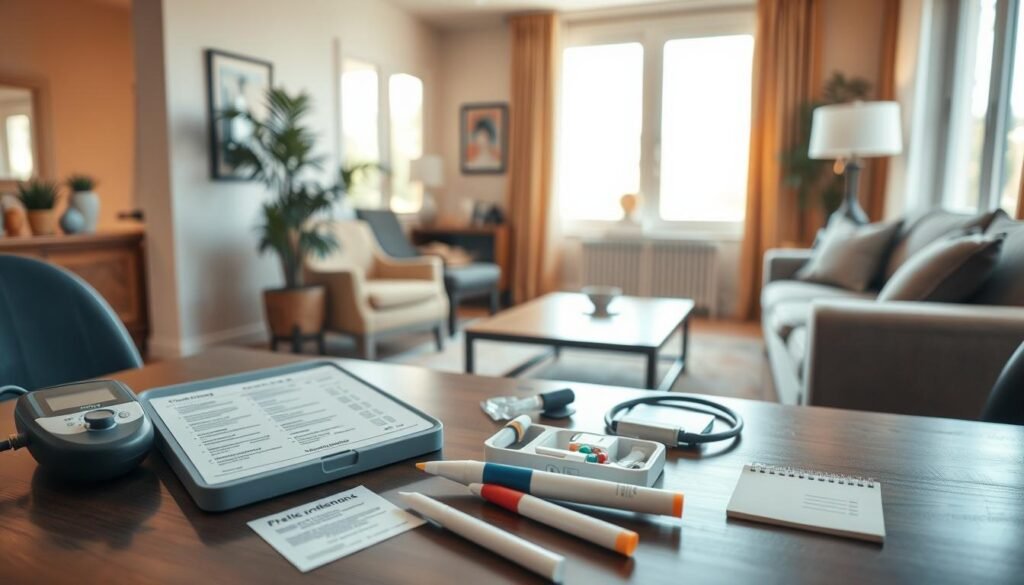
Morning collection, home pickup, and turnaround
We schedule morning collections to make fasting easier and avoid disrupting the day. Many urban services pick up a blood sample from our address.
Typical turnaround in cities is same-day, often within about 10 hours. Prices can start near Rs 250 but vary by city and service level.
Choosing reliable kits and laboratories
We prefer accredited laboratory partners with strong quality controls for confirmation. Use trusted platforms like Apollo 24|7 to book, choose home collection if needed, and get app notifications when test results are ready.
- Schedule morning slots to support fasting and accurate levels for triglycerides.
- Use lab pickup for a full lipid profile when we need confirmation of our cholesterol home readings.
- Download and share the lab profile with our clinician to align next steps for cardiovascular health.
- Compare price, accreditation, and service standards before booking to reduce surprises.
- Escalate promptly for lab confirmation if numbers suggest high risk heart attack indicators like very high LDL or triglycerides.
| Option | Speed | Best use |
|---|---|---|
| Home collection via platform | Same-day (~10 hrs) | Confirm at-home readings; convenient pickup |
| Clinic/lab visit | Same or next day | Direct lab handling for urgent concerns |
| At‑home kit | Immediate | Routine checks; repeat if unexpected |
Conclusion
Small, regular checks of our blood can make big differences in long-term heart care. A practical at-home approach complements clinical labs and helps us stay involved in day-to-day choices.
We track total cholesterol, LDL, HDL, and triglycerides and note fasting and timing for clearer levels. Favorable numbers (total cholesterol under 200 mg/dL, LDL
If readings are high or persistently abnormal, repeat the test, seek lab confirmation, and consult our clinician. Combine steady lifestyle changes with medical advice when needed, and keep testing, learning, and acting on results to protect our heart health.

